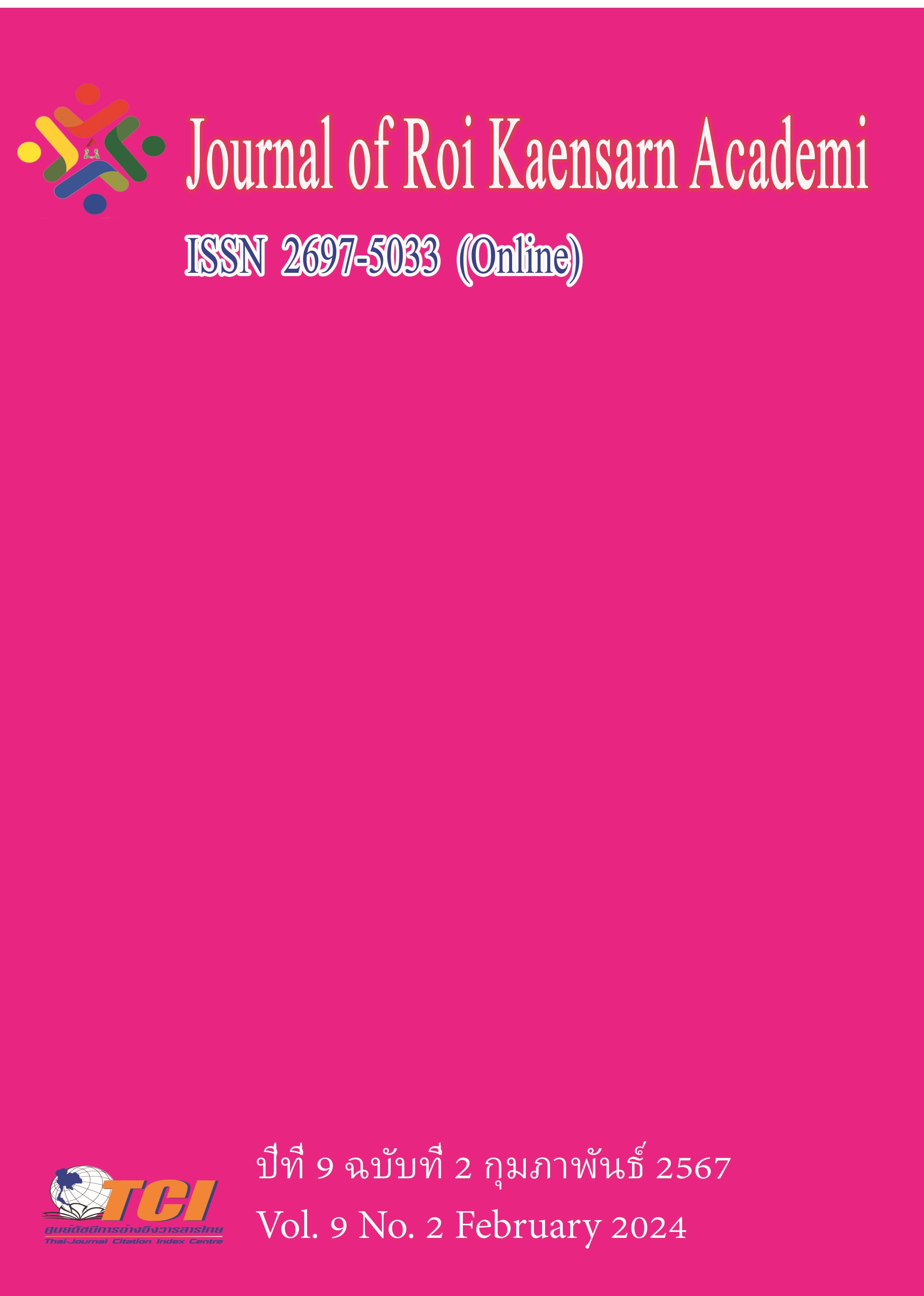อิทธิพลของรูปแบบการทำงานแบบผสมที่มีต่อทุนทางปัญญา และพฤติกรรมการทำงานเชิงนวัตกรรม
Main Article Content
บทคัดย่อ
การวิจัยนี้มีวัตถุประสงค์เพื่อศึกษา 1) อิทธิพลของรูปแบบการทำงานแบบผสมที่มีต่อพฤติกรรมการทำงานเชิงนวัตกรรม 2) อิทธิพลของรูปแบบการทำงานแบบผสมที่มีต่อทุนทางปัญญาด้านทุนมนุษย์ ด้านทุนความสัมพันธ์ และด้านทุนทางโครงสร้าง 3) อิทธิพลของทุนทางปัญญาด้านทุนมนุษย์ ด้านทุนความสัมพันธ์ และด้านทุนทางโครงสร้าง ที่มีต่อพฤติกรรมการทำงานเชิงนวัตกรรม การวิจัยนี้เป็นการวิจัยเชิงปริมาณ กลุ่มตัวอย่างที่ใช้ในการทำวิจัยครั้งนี้ คือ กลุ่มตัวอย่างที่ใช้ในการศึกษา คือ พนักงานในอุตสาหกรรมเทคโนโลยีและสารสนเทศที่เกี่ยวข้องกับงานการวิจัยและพัฒนาในกรุงเทพมหานคร และปริมณฑล จำนวน 153 คน ใช้วิธีเลือกตัวอย่างแบบเจาะจง เครื่องมือที่ใช้เก็บรวบรวมข้อมูล ได้แก่ แบบสอบถาม สถิติที่ใช้ในการวิเคราะห์ข้อมูล ได้แก่ วิเคราะห์ตัวแบบสมการโครงสร้างด้วยเทคนิควิธี PLS-SEM
ผลการวิจัยพบว่า รูปแบบการทำงานแบบผสมมีอิทธิพลเชิงบวกต่อพฤติกรรมการทำงานเชิงนวัตกรรม และยังมีอิทธิพลเชิงบวกต่อทุนทางปัญญาด้านทุนมนุษย์ ด้านทุนความสัมพันธ์ และด้านทุนทางโครงสร้าง ในขณะที่ทุนทางปัญญาด้านทุนมนุษย์ ทุนความสัมพันธ์ และทุนทางโครงสร้าง ไม่มีอิทธิพลเชิงบวกต่อพฤติกรรมการทำงานเชิงนวัตกรรม
Article Details
เอกสารอ้างอิง
จารุวรรณ ยอดระฆัง. (2563). การพัฒนาพฤติกรรมสร้างนวัตกรรมในงานของบุคลากรผู้มีศักยภาพสูงผ่านกระบวนการวิจัยเชิงปฏิบัติการบนฐานแนวคิดทุนทางจิตวิทยาเชิงบวก. ปริญญานิพนธ์ปรัชญาดุษฎีบัณฑิต. สาขาวิชาจิตวิทยาประยุกต์. สถาบันวิจัยพฤติกรรมศาสตร์ มหาวิทยาลัยศรีนครินทรวิโรฒ.
ณัฐวุฒิ พงศ์สิริ. (2563). Digital Economy … Digital HR การบริหารทรัพยากรมนุษย์ในยุคดิจิทัล. เข้าถึงเมื่อ 27 ธันวาคม. เข้าถึงได้จาก https://shorturl.at/mvU19
นิรุษา ศิริวริษกุล. (2560). ผลกระทบของความสามารถขององค์กรต่อความมีนวัตกรรมผลิตภัณฑ์: บทบาทของความได้เปรียบจากทรัพยากรที่จับต้องไม่ได้ ของอุตสาหกรรมการผลิตในประเทศไทย. วารสารมหาวิทยาลัยศิลปากร 37, 1 (มกราคม-เมษายน): 69-91.
บุญชม ศรีสะอาด. (2553). การวิจัยเบื้องต้น. พิมพ์ครั้งที่ 8. กรุงเทพฯ : สุวีริยาสาสน์.
ประเวช ชุมเกษรกูลกิจ และ ศจีมาจ ณ วิเชียร. (2561). พฤติกรรมสร้างนวัตกรรมในการทำงาน: แนวคิด ปัจจัยเชิงสาเหตุ ความท้าทาย. วารสารพฤติกรรมศาสตร์เพื่อการพัฒนา 10, 1 (มกราคม): 25-41.
สำนักงานสภาพัฒนาการเศรษฐกิจและสังคมแห่งชาติ สำนักนายกรัฐมนตรี. (2565). ร่างแผนพัฒนาเศรษฐกิจและสังคมแห่งชาติ ฉบับที่สิบสาม พ.ศ. 2566 - 2570. เข้าถึงเมื่อ 27 ธันวาคม. เข้าถึงได้จาก https://www.nesdc.go.th/download/Plan13/Doc/Plan13_DraftFinal.pdf
สุวิทย์ เมษินทรีย์. (2559). ประเทศไทย 4.0. เข้าถึงเมื่อ 27 ธันวาคม. เข้าถึงได้จากhttps://planning2.mju.ac.th/goverment/20111119104835_planning/Doc_25590823143652_358135.pdf
เสาวรัจ รัตนคำฟู และเมธาวี รัชตวิจิน. (2563). ผลกระทบของการทำงานที่บ้าน (Work from home) ในช่วงโควิด-19: กรณีศึกษาของทีดีอาร์ไอ. เข้าถึงเมื่อ 26 ธันวาคม. เข้าถึงได้จาก https://tdri.or.th/2020/05/impact-of-working-from-home-covid-19/
Almahamid, S. M., & Ayoub, A. E. A. (2022). A predictive structural model of new ways of working on innovative work behaviour: Higher education perspective in the Gulf Cooperation Council. Creativity and Innovation Management, 31(3), 410–429. https://doi.org/10.1111/caim.12510
Amankwaa, A., Susomrith, P. & Seet, P. S. (2022). Innovative behavior among service workers and the importance of leadership: evidence from an emerging economy. The Journal of Technology Transfer, 47, 506–530. https://doi.org/10.1007/s10961-021-09853-6
Amankwaa, A., Gyensare, M.A. and Susomrith, P. (2019). Transformational leadership with innovative behaviour: Examining multiple mediating paths with PLS-SEM. Leadership & Organization Development Journal, 40(4), 402-420. https://doi.org/10.1108/LODJ-10-2018-0358
Baert, S. et al. (2020). The COVID-19 Crisis and Telework: A Research Survey on Experiences, Expectations and Hopes. Accessed January 11. Available from https://www.researchgate.net/publication/341272740_The_COVID-19_Crisis_and_Telework_A_Research_Survey_on_Experiences_Expectations_and_Hopes
Brunetto, Y, Xerri, M, & Farr-Wharton, B. (2020). Comparing the role of personal and organisational support on the innovative behaviour of frontline healthcare workers in Australia and the United States. Australian Journal of Public Administration, 79, 279–297. https://doi.org/10.1111/1467-8500.12414
Budur, T., Demirer, H., & Rashid, C.A. (2023). The effects of knowledge sharing on innovative behaviours of academicians; mediating effect of innovative organization culture and quality of work life. Journal of Applied Research in Higher Education, Vol. ahead-of-print No. ahead-of-print. https://doi.org/10.1108/JARHE-08-2022-0257
Chin, W.W. (2010). How to write up and report PLS analyses, in Esposito Vinzi, V., Chin, W.W., Henseler, J. and Wang, H. (Eds), Handbook of Partial Least Squares: Concepts, Methods and Applications, Vol. 2, Springer Handbooks of Computational Statistics Series. Springer, Heidelberg: 655-690. https://doi.org/10.1007/978-3-540-32827-8
Chou, C. Y., Huang, C. H., & Lin, T.-A. (2018). Organizational intellectual capital and its relation to frontline service employee innovative behavior: consumer value co-creation behavior as a moderator. Service Business, 12(4), 663-684. https://doi.org/10.1007/s11628-018-0387-4
Davidescu, A.A.M., Apostu, S.A., Strat, V.A., Istrate Scrădeanu, A., Zgură, I.D., & Horga, M.G., 2021. The Impact of Teleworking on the Romanians Employees’ Job Satisfaction. An Empirical Evidence Based on Multiple Correspondence Analysis (MCA) and Logistic Regression. Amfiteatru Economic, 23(58), 637-653. https://doi.org/10.24818/EA/2021/58/637
De Jong, J., & Den Hartog, D. (2010). Measuring Innovative Work Behaviour. Creativity and Innovation Management, 19(1), 23-36. https://doi.org/10.1111/j.1467-8691.2010.00547.x
Diamantopoulos, A., & Siguaw, J.A. (2006). Formative vs reflective indicators in measure development: does the choice of indicators matter?. British Journal of Management. 13(4), 263-282. https://doi.org/10.1111/j.1467-8551.2006.00500.x
Esquivel, R.M. &, Solís, M. (2020). Innovative behavior in individuals and work groups: Influence of collective psychological capital, strategic directionality and the ability to reach agreements. Contaduria y Administracion, 65(2), 1-33. http://dx.doi.org/10.22201/fca.24488410e.2020.1976
Fornell, C., & Larcker, D.F. (1981). Evaluating Structural Equation Models with Unobservable Variables and Measurement Error. Journal of Marketing Research, 18(1), 39-50. https://doi.org/10.1177/002224378101800104
Petty, R., & Guthrie, J. (2000). Intellectual capital literature review. Journal of Intellectual Capital, 1(2), 155-176. https://doi.org/10.1108/14691930010348731
Hair, J.F, Hult, G.T.M., Ringle, C.M., & Sarstedt, M. (2017). A Primer on Partial Least Squares Structural Equation Modeling (PLS-SEM). 2nd ed. Thousand Oaks, CA: Sage.
Helmy, I., Adawiyah, W., & Setyawati, H. (2020). Fostering Frontline Employees’ Innovative Service Behavior: The Role of Workplace Friendship and Knowledge Sharing Process. Organizacija, 53(3) 185-197. https://doi.org/10.2478/orga-2020-
Hsu, L.-C., & Wang, C.-H. (2012). Clarifying the Effect of Intellectual Capital on Performance: The Mediating Role of Dynamic Capability. British Journal of Management, 23(2), 179-205. https://doi.org/10.1111/j.1467-8551.2010.00718.x
Johannessen, J. A. 2018). The Workplace of the Future. Accessed December 26. Available from https://library.oapen.org/handle/20.500.12657/43897
Kamukama, N. (2013). Intellectual capital: company's invisible source of competitive advantage. Competitiveness Review. An International Business Journal, 23(3), 260-283. https://doi.org/10.1108/10595421311319834
López, G., Muñoz, J. E., Cuartas, D., & Quintero, S. (2010). Assessment of intellectual capital as source for innovation. 2010 International Conference on Science and Social Research (CSSR 2010), 308-313. https://doi.org/10.1109/CSSR.2010.5773789
Mulligan, R., Ramos, J., Martín, P., & Zornoza, A. (2021). Inspiriting Innovation: The Effects of Leader-Member Exchange (LMX) on Innovative Behavior as Mediated by Mindfulness and Work Engagement. Sustainability, 13(10), 5409. https://doi.org/10.3390/su13105409
Nicolás-Agustín, Á., Jiménez-Jiménez, D., & Maeso-Fernandez, F. (2022). The role of human resource practices in the implementation of digital transformation. International Journal of Manpower, 43(2), 395-410. https://doi.org/10.1108/IJM-03-2021-0176
Pangidoan, O. T., & Nawangsari, L. C. (2022). The effect of human capital, structural capital, relational capital and innovative behavior in organizational performance of PT. PLN (Persero) Company Bekasi. Linguistics and Culture Review 6, 1 (February), 773-796.
Pooja, S., & Kanupriya, M. B. (2019). Understanding triangulated collaboration of work-life balance, personality traits and eudaimonic well-being. Problems and Perspectives in Management, 17(2), 63-82. https://doi.org/10.21511/ppm.17(2).2019.05
Putri, T., Syafitri, U. D., & Sukmawati, A. (2023). The Role of Human Resource Risk on Employee Performance in The Hybrid Workforce Era. Jurnal Aplikasi Bisnis Dan Manajemen (JABM), 9(2), 386. https://doi.org/10.17358/jabm.9.2.386
Radonic, M., Vukmirovic, V., & Milosavljevic, M. (2021). The Impact of Hybrid Workplace Models on Intangible Assets: The Case of an Emerging Country. The AMFITEATRU ECONOMIC journal, 23(58). 770-786. https://EconPapers.repec.org/RePEc:aes:amfeco:v:23:y:2021:i:58:p:770
Raišienė, A. G., Rapuano, V., Varkulevičiūtė, K., & Stachová, K. (2020). Working from Home—Who Is Happy? A Survey of Lithuania’s Employees during the COVID-19 Quarantine Period. Sustainability, 12(13). https://doi.org/10.3390/su12135332
Shaw, R., Kim, Y.-k., & Hua, J. (2020). Governance, technology and citizen behavior in pandemic: Lessons from COVID-19 in East Asia. Progress in Disaster Science, 6, 100090. https://doi.org/https://doi.org/10.1016/j.pdisas.2020.100090

